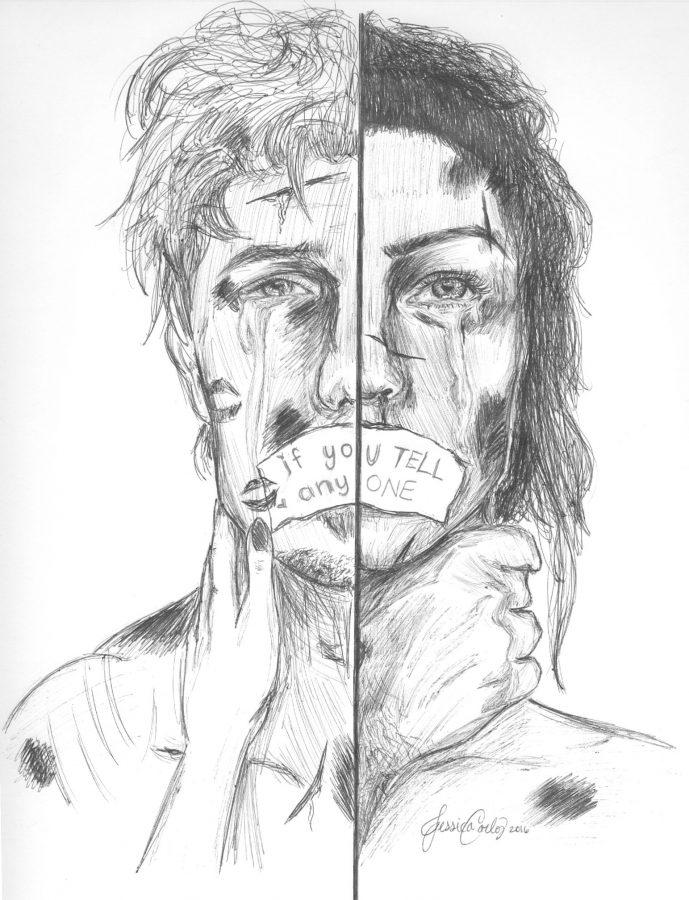Whether one finds themselves looking through their Facebook or Twitter feeds, turning on their local news station or hearing it from a friend, news travels.
It reaches the corners of the earth and impacts those who hear or read it.
While it can be a happy experience to learn they have cured swine flu or hear of a baby panda who has just been born in Japan, there can come a harder truth. The damaging, sometimes gruesome truth.
In the news there are topics that are covered and some that are not. Generally, there are some topics that people might stay away from for the uncomfortableness or the “taboo-ness” of a subject but one that some journalists have found important to touch on is sexual assault.
According to the National Institute of Justice, 36 percent of rapes, 34 percent of attempted rapes and 26 percent of sexual assaults are reported. From that statistic, an even smaller amount of stories get written about, reported or published.
Vice President of the Poynter Institute, Kelly McBride, who has been writing journalistically about sexual assault for the last 15 years has her fair share of opinions on media. But, with the rise of “Infotainment” such as E! News, The Soup, TMZ or the podcast Serial, McBride notes a shift of power from what is seen as journalistic media (CNN, ABC News or CBS News) to entertainment news shows.
“Media has come a long way but they still have a ways to go. Looking at media today, the inference of journalistic media has dwindled but entertainment media has risen and at this moment has more power,” McBride said.
Crime Reporter for The Seattle Times, Sara Jean Green, says that she has been moving from beat to beat within The Seattle Times for the last 17 years. Green often found herself back on the crime beat, though.
Within said beat, Green covers legal news ranging from murder trials, assault and robbery trials and rape trials. Green, who writes journalistically and like McBride has seen a shift to infotainment as a means of covering sexual assault.
“It is odd to me that a crime as damaging and traumatic [as sexual assault] could be seen as entertainment. The whole info and entertainment part of it is hard because whenever sex is involved it becomes weird or hard to talk about,” Green said. “The thing to really keep in mind with sexual assault is that rape is just part of the continuum on violence against women. Sexual assault is not just rape, it is misogyny, it is patriarchy and you are talking about vulnerability.”
Lecturer and Undergraduate Program Coordinator for the University of Washington in their school of communications, Ekin Yasin, touches on the social media aspect of reporting.
“We live in complicated times. For instance lying and spreading information that is not grounded on facts have become a common practice. This type of manipulation of information to reach strategic ends is becoming common place,” Yasin said. “Indeed with how one speaks or manages their identity on these [social media] platforms may impact how they are perceived. However, if we indeed were to have shared community standards about actions the impact of such management would be ineffective.”
Yasin also comments on the ways social media might affect the way people view sexual assault as well as the effect it might have on actual attackers.
“Going back to [the subject of it] toning down seriousness of certain actions, in this case we have a mixture of reactions to the attempts of normalization of assaulting women from many online/offline communities. In the meantime, same spaces, at the same time occupied discussions of how such behavior is normal. We have to ask ourselves after we express ourselves in these platforms: was I able to help facilitate a cultural change,” Yasin said.
Seeing specific cases like Brock Turner, the swimmer from Stanford University, get what some might consider a very small sentence for a very big crime has outraged many around the country.
Yasin voices her opinion on how what she considers a sentence that does not match the crime might affect the mentality of people watching.
“If our media messages and stories are of cases where assaulters systematically receive sentences that do not match the gravity of the crime than that is a problem. I think part of our discussion and online/offline coverage ought to be about the legal process,” Yasin said.
While Yasin believes that social media can change the mentality of certain people, McBride sees social media more as a tool to let people of similar beliefs find one another and that social media acts as a filter bubble for certain beliefs and that that is what affects the mentality.
“I do not think [social media] has [changed views on sexual assault]. I think it has allowed like-minded people to come together, like sexual assault survivors being able to find people and share their stories. But the other side of that is sexual assault deniers, people who deny that it happens as often as it does, are also able to find like-minded people,” McBride said.
While some find it important to expose issues like sexual assault in a public, Yasin notes the struggle between what is public and private for the media.
“This [the impact] is a sensitive subject matter. Even if we would want to have frequency of coverage for the sake of exposing a serious issue for many individuals across very many communities, not everybody wants exposure (in the way in which it comes with media coverage). We have to be mindful of the fact that this is public issue that impacts individuals in the most private way possible,” Yasin said.
While sexual assault encompasses anything from groping and unwanted touching to completed or attempted rape, there is a subset for different types of rape, from acquaintance rape, familial rape or stranger rape.
In the media though McBride has seen a shift from media covering stranger rape to the covering acquaintance rape and the distortion that can come from the focus being on only one type of rape.
“Media has changed. When I first started working on this issue 15 years ago, looking at content analysis, [the media] was only covering stranger assault. Now looking at content analysis, there is mainly coverage on acquaintance-rape, not so much with familial rape but the view is distorted,” McBride said.
As a court reporter, Green notes the difficulty in choosing what stories will be considered newsworthy and what might cause things like stranger rape, which she says happens rarely, being covered more often in the media.
“The problem is that I cannot report on everything. I cannot report on every single case because not every one of them is going to meet the threshold for what is newsworthy. So, I think that that is why you may see stranger rape cases getting reported because it is more shocking. Things that are a danger to public safety become more prevalent in the media,” Green said.
With the introduction of social media in the sharing of information, Yasin notes how it can spread a trial or case that may at one point have stayed in the confines of certain circles to a viral pandemonium.
“There is indeed more visibility and discussion of events. We see victim’s testimonies/letters go viral exposing to us to the extraordinarily difficult and heartbreaking circumstances they face. Perpetrators also are aware that this is a sharing culture- thus the cases do not just stay within immediate communities but move beyond the context of the crime,” Yasin said.
As a reporter, Green has found herself hearing stories that she finds heartbreaking. Through this she has formed opinions and believes that a large part of the problem of sexual assault is the focus on women’s actions. Green also explains how rape fits in with a larger problem of violence against women.
“So much of it is put on the women. I think that we need to shift the conversation to men. Touch on men’s sexual entitlement and men’s behavior. I see that a ton when I am covering prostitution. The age of consent in this state is 16 but there are 14 and 15 year olds being arrested for things that had money not been exchanged it would not have even been able to consent to sex,” Green said. “Now, a lot of our laws have changed but you have men out trolling for not just children but for women. Rape is just part of the continuum at the extreme end for sexual assault against women.”
Green finds the fact that sexual assault is so non-discriminatory in choosing its victims to be especially horrifying. Green also points out the differences for women in more vulnerable positions.
“It can happen to anyone and that is the horrifying part about it. Obviously some women are going to be more vulnerable to it, like if someone is living in a tent with no locks and no way to protect themselves, living underneath the freeway, that is going to make you more vulnerable. If you are involved in the sex-trade industry that is going to increase your vulnerability but it is all part of the same spectrum,” Green said. “Shifting our focus from what women are doing and looking at what men are doing because their behavior is important. I have found though that when I point that out a lot of my male readers will get angry with me,”
While the brain is complex and unique to everyone, some might find a generalized idea of what happens during sexual assault. The most common being the action of fight or flight. Green holds the belief that while it is one thing that can happen, exploring the different responses a brain can have will increase understanding and help people become more aware.
“The emphasis is just so heavily put onto women you know? What did you order at the bar? What were you wearing? Did you drink too much? The focus is just so focused on what women are doing. I think there needs to be a stronger understanding of what happens in the brain during sexual assault like that. Something I have looked at over the years is what is happening in the brain during a sexual assault,” Green said. “Like, people know about fight or flight but something that does not get looked at in rape induced paralysis. Your brain just gets so flooded with chemicals that you literally just freeze up and it can make women feel guilty for not fighting and reduce credibility in the eyes of people who are scrutinizing these women.”
The aftermath of sexual assault can bring many plaguing effects and Green highlights some of the ways these effects can bring to survivors.
“Not even focusing on the emotional impact, look at the economic impact; time lost at work, therapy sessions and physical impact is its own thing. I am not saying that women are not resilient or cannot recover, because they do and can but the impact is still there on all these aspects of their life. And it does not just impact women who have been sexually assaulted but all women because they walk around with that fear,” Green said.
Over her 17 years of writing for The Seattle Times, Green has written many stories and hopes that they have an impact on her readers.
“I think that as the reporter it is so hard to see what the impact your stories have on the community, you know to see the ripples that they can send out. I think that, judging by the emails I receive, that, yes the stories that we write do have an impact. As a writer you hope that your work reaches people and you are not just sending this stuff out into the void,” Green said.
While it may be easy to get wrapped up in the human who has committed these crimes, Yasin says that we can use cases to highlight faults in our legal systems.
“I think we have to think about what it does to cases like this: does it bring awareness? I am not also sure if we indeed have viewpoints in cases like this. We do know that such cases are prevalent and that they are awful. However, perhaps cases like and its social media exposure shows to us shortcomings of the legal system,” Yasin said.
Media Affects Cultural Perspective
Shayla Jones, Coverage Editor
Published December 15, 2016
Story continues below advertisement
0
Donate to The Viking Vanguard
$15
$500
Contributed
Our Goal
Your donation will support Viking Student Media and the content we create. Your contribution will allow us to purchase equipment and cover our annual costs, including website hosting, printing the newspaper and yearbook, and purchasing new equipment.
More to Discover
About the Contributor

Shayla Jones, Managing Editor
Shayla Jones, joined The Viking Vanguard her junior year of high school. Jones enjoys writing both journalistically and poetically. Jones also enjoys reading and listening to music. Jones has been a part of drama ever since she was in seventh grade and is still involved today. Drama brings her a feeling of happiness as well as belonging, a feeling, she says, you cannot get anywhere else.



